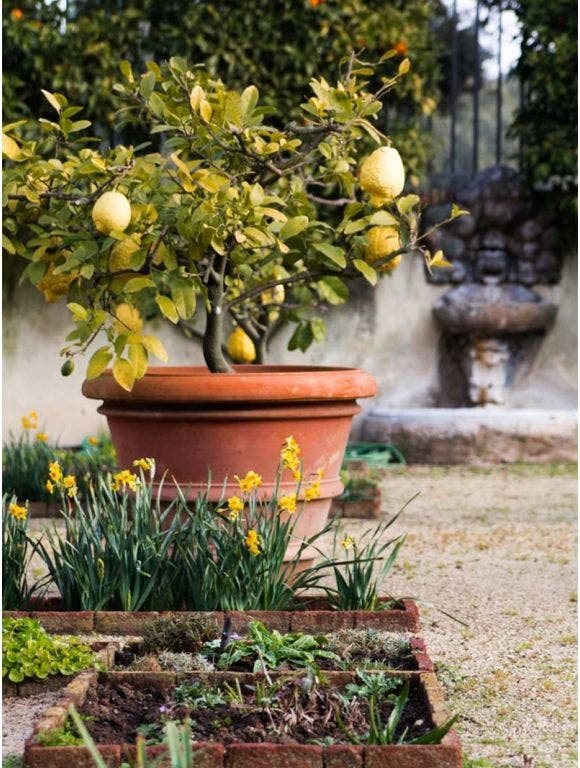


Lemon trees are a popular addition to any garden for a good reason. When they're healthy, they can produce an abundance of lemons with a variety of uses. Proper care can help your lemon tree thrive and provide you with more lemons than you know what to do with. Learn more about essential maintenance and how to address common lemon tree troubleshooting concerns.
Basic Lemon Tree Care
If you want your lemon tree to thrive, first you'll need to start with the basics.
Sunlight
Lemon trees require full sun, meaning at least six hours or more daily. If you're growing your lemon tree in a pot, you might consider placing it on a wheeled stand so you can easily move it if needed. If you live in a cooler garden growing zone, planting in a pot can also allow you to move your tree into a greenhouse or indoor space during the winter.
Water
Once your lemon tree is established and mature, it shouldn't require watering more than once a week, depending on your climate zone. You'll want to keep the soil around your tree moist but not soggy during the hot summer months. During periods of rain, you should avoid watering entirely. Mulch can help keep moisture levels steady, but don't pile mulch around the tree's base to ensure that water doesn't pool there, which can lead to root rot and attract pests. Avoid getting the foliage wet as this can lead to fungal issues.
If you're growing your lemon tree in a pot, it will require more frequent watering as potting soil dries out much faster. Keep the soil consistently moist without making it soggy. Be sure your tree is in a well-draining pot to avoid the possibility of root rot.
Fertilizer
As a fruit-bearing plant, lemon trees use a lot of energy to grow and produce lemons, which means they require fertilizer to sustain the right level of nutrients. Fertilizer containing a balanced mix of nitrogen, phosphate and potassium is the best choice to help promote growth. While you can supplement with organic compost, it won't provide enough nitrogen on its own to support a lemon tree's needs. It's best to feed your tree throughout the growing season. Feed it three times starting in late winter/early spring, again in late spring/early summer and once more at the end of summer.
Common Lemon Tree Troubleshooting Questions
Learning to care for your lemon tree can take some time and experience. These are some common concerns with lemon tree troubleshooting and how to address them.
How to Prune a Lemon Tree
Routinely pruning your lemon tree in the first couple of years can help encourage growth and build a solid canopy that will produce more fruit. How you prune your lemon tree will depend on how you want it to grow. Depending on how you prune, you can train the tree to grow tall or short and wide. This is especially helpful if you're growing a tree in a pot or indoors and need to keep it on the smaller side.
Each variety of lemon tree will have a different growth rate and size, but generally, pruning long branches and pinching back foliage in younger trees will encourage fruit growth and solid branch structure. Pruning back fruit and blossoms when the tree is younger can also help the plant develop a stronger trunk and branches.
Early spring or late winter is the best time to prune a lemon tree. Before you begin, ensure your tools are sharp and disinfected to prevent damage or disease. Cut back any dead or diseased growth, and clean your tools again before moving on to healthy branches. Thin out branches to allow more light and air to filter through. Make your cuts above leaves and leave at least 1/2 foot of larger, more mature branches to prevent the plant from going into shock.
Consider the aesthetic and shape of the tree when pruning. Remove long parallel growing branches that may be competing by pruning off the inner shoot. Snip away any base shoots (also called suckers) growing along the bottom of the tree. Never cut back more than a third of the plant in one year unless the tree is in bad condition and you're attempting to revive it. In that case, you can prune back up to one-half of the tree's branches.
How to Prevent Lemon Tree Pests
Common citrus tree pests include scale, leafminers, aphids, whiteflies and mealybugs. Correct watering and pruning can help prevent these pests from infesting your tree. No matter how much care you take, however, you may notice signs of a pest at some point.
Treatment with insecticidal soap or horticultural oil can help eliminate most citrus plant pests. The best time of day to apply is either early in the morning or late afternoon/early evening. Follow the directions on the container and treat the entire tree, getting the undersides of leaves as well.
You can identify a leafminer infestation by the silvery lines or tunnels left behind on the leaves. Prune away any infected leaves and treat the plant with horticultural oil.
Aphids appear as tiny, green soft-bodied insects, often sitting on the plant in slow-moving clusters. You can try introducing natural enemies, like ladybugs, to control aphids or treat them with horticultural oil.
Scale, mealybug and whiteflies, as well as aphids, are sap-sucking insects. You'll notice an infestation by the sticky liquid left behind on leaves after they feed on your plant. This honeydew can create mold, which leads to growth issues and falling leaves. Treat an infestation with a soap and water solution or horticultural oil.
How to Treat Lemon Tree Diseases
Lemon trees are unfortunately susceptible to diseases. Common bacterial infections include bacterial blast and citrus canker. Bacterial blast causes black spots on leaf stems and curled leaves that dry and drop. Prune back any diseased areas to prevent spread. You can preventatively use copper sprays before the rainy season to help stop bacterial infection. Pruning during dry seasons can also help prevent bacteria.
Citrus canker is identifiable by raised spots or lesions on the sides of the leaves. Left unchecked, these spots can grow into holes. Prune diseased areas and treat with copper spray.
Common fungal diseases in lemon trees include root rot and botrytis. Signs of root rot are poor growth and small yellowing leaves. It can be challenging to treat, as the signs typically don't appear until the disease fully sets in. Depending on the type of rot, there may be no saving the tree by the time you notice it. The best way to prevent root rot is to avoid overwatering and standing water near the tree's base. Cut back or eliminate watering during rainy periods and bypass mulch in moist climates.
Botrytis is another common fungal disease that affects the fruit, leading to premature dropping and fruit injuries. Regular pruning and preventative spraying with copper fungicide can help stop the development of botrytis.
What to Do if Leaves Look Unhealthy
Besides diseases and pests, the leaves on your lemon tree may appear unhealthy or start dropping for other reasons. Nutrient deficiencies can cause discolored, yellow or curling leaves. If you don't see any signs of pests but your leaves don't look healthy, try a soil test to determine if there's a deficiency. The right formula of fertilizer can treat nutrient deficiencies.
Climate can be another cause of leaf issues. Frost, hail, sun and wind can all lead to leaf and twig damage. While you can't control the weather, it's vital to prune damaged areas, which may be more susceptible to disease. If you're growing your lemon tree in a pot, moving it during extreme weather conditions can help protect it.
Water issues can also cause leaves to drop. Both overwatering and underwatering can cause a lemon tree to lose leaves. Striking the right balance of water can make all the difference in a healthy lemon tree. Adjust your watering habits based on the time of year and climate.
With regular care and maintenance and a watchful eye, you can enjoy a healthy lemon tree that produces fruit year after year.
Don't have space for a large garden? Learn more about how to grow lemons and other citrus fruits in pots with Burpee's guide to growing trees in pots.



